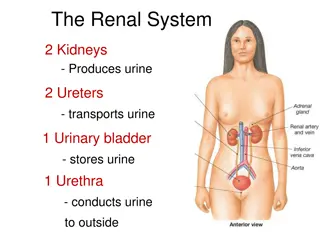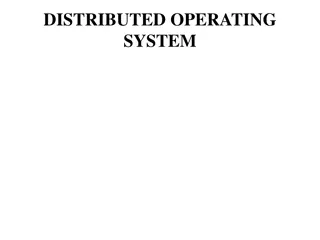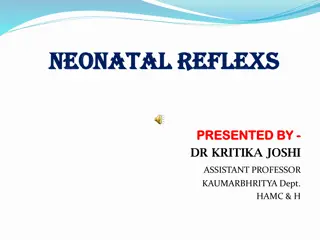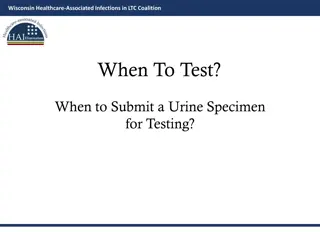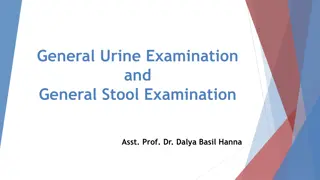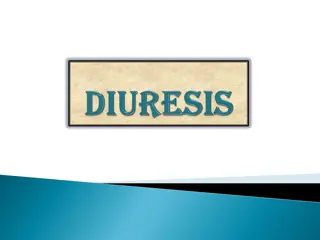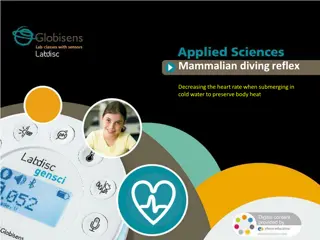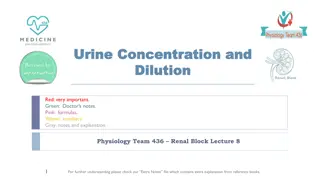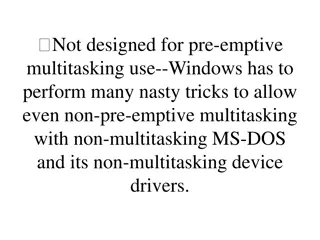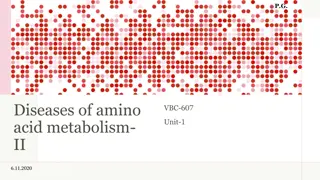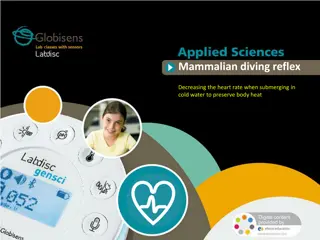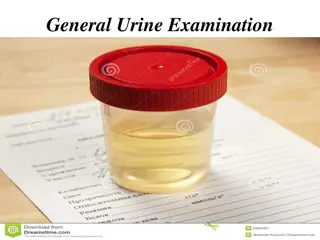Reflex Urine Culturing in UTI Diagnosis: Dos and Don'ts
Reflex urine culturing is a crucial diagnostic strategy for UTIs in hospitalized patients, emphasizing the importance of suspicion over urinalysis. Misuse can lead to increased positive cultures. Understanding the relevance to SPARC and focusing on diagnostic stewardship can help prevent unnecessary antibiotic use. Common challenges in UTI diagnosis include overtesting and the necessity for specific symptoms. Symptoms, positive urine culture, and pyuria are key elements in diagnosis.
Download Presentation

Please find below an Image/Link to download the presentation.
The content on the website is provided AS IS for your information and personal use only. It may not be sold, licensed, or shared on other websites without obtaining consent from the author.If you encounter any issues during the download, it is possible that the publisher has removed the file from their server.
You are allowed to download the files provided on this website for personal or commercial use, subject to the condition that they are used lawfully. All files are the property of their respective owners.
The content on the website is provided AS IS for your information and personal use only. It may not be sold, licensed, or shared on other websites without obtaining consent from the author.
E N D
Presentation Transcript
Reflex urine culturing: Dos and Don ts Surbhi Leekha MBBS, MPH Associate Professor University of Maryland School of Medicine
Take Take- -home points home points 1 2 3 Reflex urine culturing is a key diagnostic stewardship strategy for UTI among hospitalized patients The starting point for a reflex urine culture is suspicion of UTI, not a urinalysis Misuse of reflex urine culturing can paradoxically increase incidence of positive urine cultures
Relevance of UTI diagnosis to SPARC Relevance of UTI diagnosis to SPARC Diagnostic stewardship is the process of improving ordering, processing, and reporting of infection diagnostic tests improve antimicrobial use Distinct SPARC domain(s) UTI common cause of unnecessary antibiotic use and focus of diagnostic stewardship https://maryland-sparc.org/index.html
Why should we focus on the diagnostic aspect? Why should we focus on the diagnostic aspect? Original Goal: Avoid treatment of asymptomatic bacteriuria Efforts to increase Awareness of asymptomatic bacteriuria (ASB) Knowledge of lack of benefit from ASB treatment However Positive urine culture STRONG stimulus to treat, regardless of symptoms Revised Goal: Avoid ordering & reporting of unnecessary urine cultures a.k.a. Diagnostic stewardship for UTI
Why is UTI over Why is UTI over- -testing common among testing common among hospitalized patients? hospitalized patients? Culturing for inappropriate symptoms Change in urine character Non-specific appropriate symptoms: fever, leukocytosis Pan -culturing for fever or sepsis 50% of patients with NHSN-CAUTI and 30% with clinical CAUTI diagnosis have alternate cause of fever True urinary symptom-based urine culturing is difficult to achieve in hospitalized patients Leekha ICHE 2015
What about other elements of UTI diagnosis? What about other elements of UTI diagnosis? Non-specific in hospital setting Common in hospital, catheter, elderly 1. Symptoms 2. Positive urine culture (bacteriuria) 3. Pyuria (urine WBC) 1 + 2 = Bad Combination
Pyuria and UTI Pyuria and UTI Urine WBCs or pus cells or pyuria: Inflammation in the urinary tract Presence of pyuria has low positive predictive value Positive UA or pyuria UTI However, absence of pyuria has high negative predictive value Absence of pyuria in a patient with non-specific symptoms (e.g., fever) suggests an alternative cause for fever Basis of reflex urine culturing Juthani-Mehta M, ICHE 2007 Tambyah PA Arch Intern Med 2000 Stovall RT, J Am Coll Surg 2013
Reflex Urine Culturing: Protocol Reflex Urine Culturing: Protocol Perform urine cultures only when urinalysis / microscopy criteria met Replaces a routine or regular urine culture order Most commonly used criteria: Pyuria (UA WBC > 10 per hpf) Threshold of 10 supported by literature and lab Cumitech guide Leukocyte esterase in UA WBCs on microscopic exam Other criteria: nitrite, bacteria Different from pyuria presence of bacteria Not all bacteria reduce nitrate to nitrite Does not say anything about inflammation Humphries J Clin Micro 2016 Cumitech ASM Press 2014
When order is placed, 2 labels print for urine collection: yellow top tube (UA) and grey top tube (urine culture) Both tubes sent to lab accessioning with appropriate volumes Workflow (University of Maryland Medical Center) Lab Accessioning sends yellow top tube to Chemistry and grey top tube to Microbiology Urinalysis performed in the Chemistry lab WBC result of > 10per hpf generates order for urine culture visible to the Microbiology lab, and a urine culture is performed If no urine culture order generated for Microbiology, the specimen for urine culture is discarded
Impact: Impact: Significant decreases in urine cultures performed, Significant decreases in urine cultures performed, bacteriuria, and CAUTI bacteriuria, and CAUTI Epstein ICHE 2016 Sarg ICHE2016
Impact: Antimicrobial Use Impact: Antimicrobial Use Among randomly selected 250 ICU patients pre- and post-intervention who had urine culture ordered Fewer patients with positive urine cultures post vs. pre (40 vs. 77, P <.001) Fewer patients started new antimicrobial therapy for UTI post vs. pre (23% vs 41%, P= .002) No change in overall ICU antimicrobial days of therapy 2 DOT for every urine culture ordered: intimate link between culturing and antibiotic use Sarg ICHE 2016
Stakeholders Stakeholders Antimicrobial Stewardship (reduce unnecessary UTI treatment) Infection Prevention (reduce reported CAUTI) Lab/Microbiology (reduce volume of cultures to work-up) Hospital Leadership ($$$) Clinicians Providers Urology Nurses IT: Orders analyst, lab IT
Reflex Urine Culturing Dos Reflex Urine Culturing Dos (1) Map hospital process for ordering, collection, processing of urinalysis and urine cultures Review all order-sets with urine culture orders Remove where unnecessary! Wherever possible, make reflex urine culture the default urine culture order Consider exceptions: pregnancy, urology, renal transplant, neutropenic Unable to exhibit pyuria Positive urine culture significant regardless of pyuria
Reflex Urine Culturing Dos Reflex Urine Culturing Dos (2) Automate process at level of the lab When urinalysis criteria met, order for urine culture generated for Microbiology lab Work with Lab IT Avoid manual checking of UA result and urine culture order placement: delays
Reflex Urine Culturing Dos Reflex Urine Culturing Dos (3) Ensure specimen collection and transport for urinalysis and urine culture occurs simultaneously Kits are helpful Avoids later urine culture collection when results may be affected by antibiotic use or specimens sitting at bedside
Reflex Urine Culturing Dos Reflex Urine Culturing Dos (4) Use reflex urine culturing as part of overall diagnostic stewardship strategy Ordering in presence of symptoms Best practices for reporting Not reporting individual organisms in mixed flora
Reflex Urine Culturing Dos Reflex Urine Culturing Dos (5) Supplement with additional IT interventions to facilitate appropriate ordering Order panels with appropriate indications Can be customized for different patient populations (e.g., patients with and without indwelling urinary catheter) Best practice alerts e.g., guide to urine reflex when regular urine culture selected Reports with feedback of urine culture orders
Reflex Urine Culturing Donts Reflex Urine Culturing Don ts (1) Do not make the urinalysis the starting point for UTI diagnosis Always start with symptoms Common fallacy: Screening UA regardless of symptoms, ED triage Paradoxical increase in UTI rates Reason: expanded pool of asymptomatic people tested, non- specific pyuria and bacteriuria detected
Reflex Urine Culturing Donts Reflex Urine Culturing Don ts (2) Do not eliminate routine urinalysis Urinalysis has many other uses beyond infection diagnosis Evaluation of kidney injury Diabetes Electrolyte abnormalities If no routine urinalysis option, then positive UA in asymptomatic patients/patients with UA sent for non-infectious reasons will reflex to culture ASB not UTI (recall that positive UA or pyuria UTI)
Current state: urine culturing practices survey Current state: urine culturing practices survey among SHEA Research Network members among SHEA Research Network members Of 52 hospitals, 26 (50%) performed reflex urine cultures 24 (92%) also allowed urine culture without reflex Criteria for positive urinalysis varied 96% using different WBC thresholds 76% also using positive leukocyte esterase or nitrite Perceived impact on UTI rates 27% saw decrease 27% perceived no change 11% observed an increase Only 4 required documentation of indication while ordering urine cultures Implementing in ED or outpatient Sullivan ICHE 2019
Take Take- -home points home points 1 2 3 Reflex urine culturing is a key diagnostic stewardship strategy for UTI among hospitalized patients The starting point for a reflex urine culture is suspicion of UTI, not a urinalysis Misuse of reflex urine culturing can paradoxically increase unnecessary urine cultures



